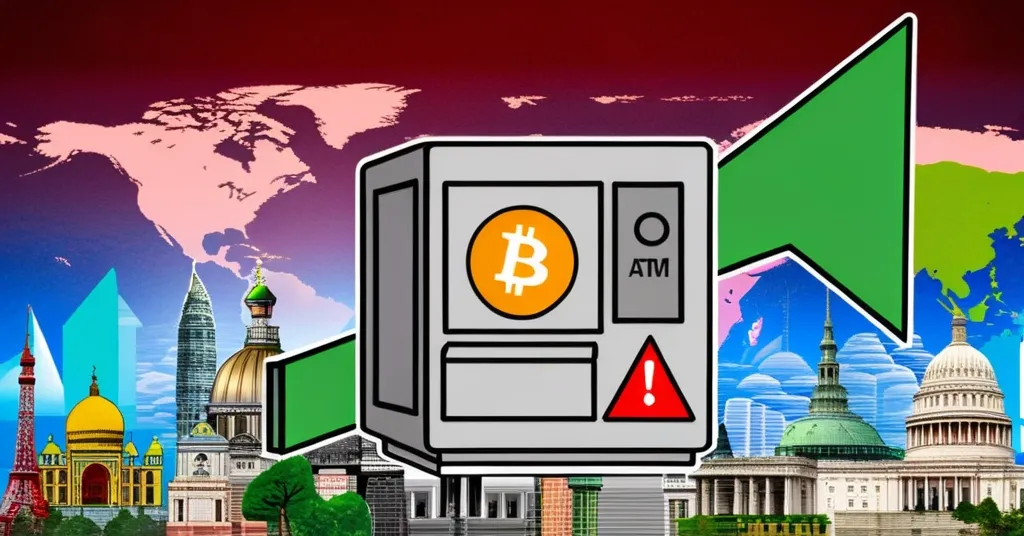Bitcoin ATMs Grow 6% in 2024, But Scams and Regulations Surge

Bitcoin ATMs Surge 6% in 2024 Amid Crypto Resurgence
Despite a global surge in Bitcoin ATMs, the crypto world isn’t all sunshine and roses. While these machines make cryptocurrencies more accessible, they also bring increased regulatory scrutiny and a surge in scams.
- 6% global growth in Bitcoin ATMs in 2024
- Over 37,500 machines worldwide
- U.S. dominates with 81% of global market
- Increased regulatory scrutiny and scam surge
By the start of 2024, the world saw over 37,500 Bitcoin ATMs spread across more than 70 countries. These machines allow users to buy and sell cryptocurrencies using cash or bank cards, bridging the gap between traditional finance and the digital realm. The U.S., with its 31,500-plus machines, remains the center of this trend, holding over 81% of the global market as of January 13, 2024. This dominance isn’t surprising given the U.S.’s early adoption and ongoing interest in cryptocurrencies.
Europe also saw a share of growth, with a 7.5% increase in Bitcoin ATMs, adding 116 new machines to its tally. This regional difference highlights the varied pace at which cryptocurrency adoption is spreading globally. However, the enthusiasm for Bitcoin ATMs slowed down after the first half of the year, with only 34 machines installed per month on average in the second half, compared to a more robust 1,942 in the first. It’s a bit like a crypto rollercoaster that loses steam halfway through the ride.
As these machines spread, so too does regulatory attention. In the U.S., Bitcoin ATM operators must navigate a complex landscape, registering as money services businesses and adhering to laws to prevent illegal activities like money laundering (AML) and rules to verify customer identities (KYC). These requirements aim to prevent fraud and money laundering but also present significant operational challenges. It’s like trying to dance to a tune that’s constantly changing.
Internationally, regulatory enforcement has been swift and decisive. In the U.K., Olumide Osunkoya was convicted for operating an illegal network of crypto ATMs, while in Germany, the financial regulatory authority BaFin conducted a sting operation, seizing 13 ATMs and $28 million in cash linked to unlicensed operations. Authorities are cracking down hard on illegal Bitcoin ATM operations, showing that the crypto space isn’t the Wild West anymore.
The number of Bitcoin ATMs keeps growing, making it easier for people to buy and sell cryptocurrencies.
Yet, with growth comes the dark side of the crypto world. Scams associated with Bitcoin ATMs have surged, with reported losses reaching over $110 million in 2023 and an additional $65 million in the first half of 2024. Older adults, particularly those aged 60 and above, have been the most vulnerable to these schemes, which often involve government impersonation, business impersonation, and tech support fraud. It’s a cruel irony that those who might be least familiar with technology are being targeted by tech-related scams.
New data from the Federal Trade Commission shows a huge rise in the amount of money consumers report losing to scams involving Bitcoin ATMs.
Some argue that Bitcoin ATMs are an unnecessary risk, driving mainstream adoption at the cost of increased fraud. Others see them as a vital tool for bringing cryptocurrencies to the masses, offering a tangible entry point into the world of digital assets. The decentralized nature of cryptocurrencies offers unprecedented freedom and privacy, but it also requires vigilance and robust measures to protect users. As we champion the disruption of the financial status quo, we must also confront the darker aspects of this revolution.
The surge in Bitcoin ATMs reflects the broader interest in cryptocurrencies, yet it also underscores the challenges of fraud and regulatory compliance. As the crypto landscape evolves, the balance between innovation and security remains a critical issue. The surge in ATMs, especially in the U.S., shows a robust demand for easy access to cryptocurrencies, but the scams and regulatory crackdowns serve as a reminder of the risks involved.
While the optimism around Bitcoin and blockchain technology remains strong, the challenges are real and must be addressed. The future of Bitcoin ATMs will depend on how well the industry can navigate these challenges, ensuring that the promise of decentralization and financial freedom isn’t overshadowed by fraud and regulatory hurdles.
- What was the growth rate of Bitcoin ATMs in 2024?
The growth rate was 6% globally.
- Which country has the largest share of Bitcoin ATMs?
The U.S. has the largest share, with over 81% of the global market.
- How did Europe’s Bitcoin ATM market perform in 2024?
Europe added 116 new Bitcoin ATMs in 2024, marking a 7.5% increase from the previous year.
- What regulatory challenges do Bitcoin ATM operators face?
Operators must comply with laws to prevent illegal activities like money laundering and rules to verify customer identities, register as money services businesses, and adhere to state and local regulations, which vary by country.
- What are the main types of scams associated with Bitcoin ATMs?
The main scams involve government impersonation, business impersonation, and tech support scams.
- Who is most affected by Bitcoin ATM scams?
Older adults, particularly those aged 60 and above, are most affected by these scams.
- What significant regulatory actions were taken against Bitcoin ATMs in 2024?
In the U.K., a man was convicted for operating an illegal network of crypto ATMs, and in Germany, authorities seized 13 ATMs and $28 million in cash linked to unlicensed operations.



